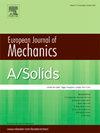Influence of shell thickness and lattice infill on the mechanical performance of a biomimetic alligator mandible structure
IF 4.2
2区 工程技术
Q1 MECHANICS
引用次数: 0
Abstract
Biomimetic designs that draw inspiration from structures found in nature provide a unique approach to engineering solutions and can reveal innovative concepts. The use of hollow-walled designs with porous infill provides an opportunity to achieve highly efficient structural designs. However, the experimental application of using hollow-walled designs as an approach to increase the efficiency of biomimetic structures is yet to be explored. This paper hence investigates the influence of shell thickness and lattice infill on the mechanical performance of a biomimetic structure using the example of an alligator mandible. Experimental and numerical approaches were employed to assess the mechanical properties of additively manufactured mandible structures under bending and compressive loading conditions. Finite element simulations were validated against mechanical testing and quantitative thermoelastic stress analysis (TSA). The shell thickness of the mandible was found to be more critical to the specific bending and compressive stiffness of the structure compared to the inclusion of the lattice infill. The TSA scans quantified the effect of shell thickness and infill on the unique surface stress distribution of the mandible, which increased with a reduction in shell thickness. These findings highlight the potential of hollow-walled designs as an approach to create more efficient, and optimised, biomimetic structures. This methodology can be applied to alligator mandible-like designs for load-bearing engineering applications that involve complex loading conditions, such as cantilevered bracket structures.
壳厚和晶格填充对仿鳄鱼下颌骨结构力学性能的影响
仿生设计从自然界中发现的结构中汲取灵感,为工程解决方案提供了独特的方法,并可以揭示创新的概念。使用多孔填充物的空心壁设计为实现高效的结构设计提供了机会。然而,利用空心壁设计作为一种提高仿生结构效率的方法的实验应用还有待探索。因此,本文以鳄鱼下颌骨为例,研究了壳厚度和晶格填充对仿生结构力学性能的影响。采用实验和数值方法对复合材料下颌骨结构在弯曲和压缩载荷作用下的力学性能进行了研究。有限元模拟与力学测试和定量热弹性应力分析(TSA)进行了对比验证。与包含点阵填充物相比,发现下颌骨的壳厚度对结构的特定弯曲和压缩刚度更为关键。TSA扫描量化了壳体厚度和填充物对下颌骨独特表面应力分布的影响,其随壳体厚度的减小而增加。这些发现突出了空心壁设计作为一种创造更高效、优化的仿生结构的方法的潜力。这种方法可以应用于鳄鱼下颌骨设计,用于涉及复杂载荷条件的承重工程应用,如悬臂支架结构。
本文章由计算机程序翻译,如有差异,请以英文原文为准。
求助全文
约1分钟内获得全文
求助全文
来源期刊
CiteScore
7.00
自引率
7.30%
发文量
275
审稿时长
48 days
期刊介绍:
The European Journal of Mechanics endash; A/Solids continues to publish articles in English in all areas of Solid Mechanics from the physical and mathematical basis to materials engineering, technological applications and methods of modern computational mechanics, both pure and applied research.

 求助内容:
求助内容: 应助结果提醒方式:
应助结果提醒方式:


